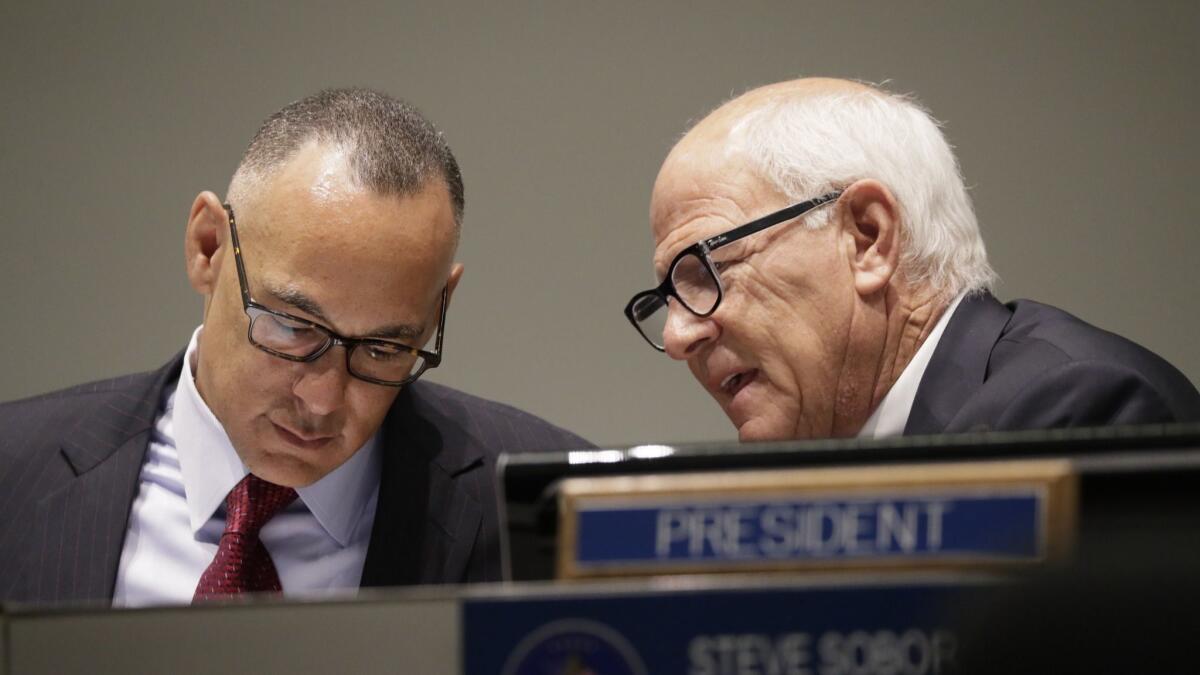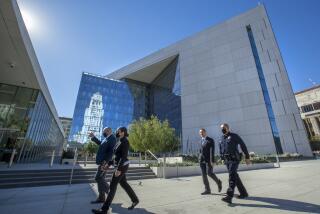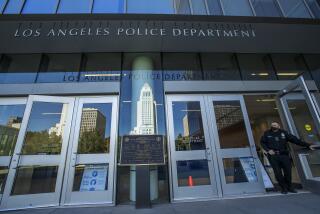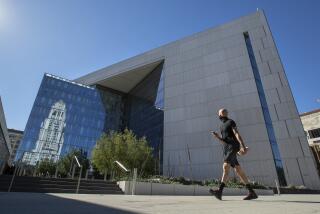LAPD to reverse policy and make body camera, patrol car videos public

The Los Angeles Police Department’s years-long practice of keeping video from body cameras and patrol cars under wraps will soon end after the agency’s civilian bosses approved a policy Tuesday that requires the release of recordings in the future.
The 4-0 vote by the Police Commission marks a dramatic turnaround for a department that refused to make such footage public even as it rolled out thousands of body cameras to officers in recent years.
The new approach will give the public a firsthand look at some of the most crucial moments involving the LAPD, including shootings by officers, deaths that occur in their custody and other encounters when they use force that kills or seriously injures someone.
“Transparency and accountability are the bedrocks of building public trust,” said Commissioner Shane Murphy Goldsmith, who helped draft the policy. “The public has a right to see these videos.”
The implications could be felt beyond Los Angeles, as the release of video has become a central issue in the push for greater transparency in policing. Law enforcement agencies across the country are still struggling with when and how to release video — if at all. In California, lawmakers’ attempts at a statewide answer have repeatedly stalled, leaving a patchwork of policies with varying degrees of public access.
Matt Johnson, the commission’s vice president who spearheaded the policy reversal, said he and others hoped the LAPD’s new approach would become a model for other agencies.
“I think this will go a long way in helping build public trust through a significant increase in transparency,” he said.
Video can be a crucial piece of evidence in encounters involving police officers, both for those investigating the incidents and for outsiders interested in how they unfolded. For many, the release of those recordings offers residents the chance to see for themselves exactly what happened, rather than rely on sometimes-conflicting accounts from police and witnesses.
The public has a right to see these videos.
— Police Commissioner Shane Murphy Goldsmith
But opponents fear that making such footage public could thwart an investigation, inflame tensions between the public and the police or, as LAPD Chief Charlie Beck has said, offer a limited, incomplete snapshot of an incident if other evidence isn’t also shared.
The issue has become more pressing as the LAPD added body cameras and video equipment in their patrol cars — roughly 8,300 cameras in all when the deployments are finished in the coming weeks. The department has collected millions of recordings, a small fraction of which will be publicly available under the new policy.
Other evidence will be released along with the video — information that until now the public usually reads about in reports summarizing an incident that typically are published about a year later. That could include recordings of 911 calls, witness statements, photos from the scene or details about the weapons used, Beck said.
READ: The new rules for releasing LAPD video »
Under the new rules, video from “critical incidents” involving the police will automatically become public within 45 days after they occur. The Police Commission or police chief could also opt to release video from other encounters if they decide it is “in the public interest.”
The policy extends beyond video captured by police cameras. Other images the LAPD has of critical incidents, including recordings from security cameras or bystanders’ cellphones, will also be made public.
There is also a caveat that allows the release to be delayed if the police chief and two commissioners unanimously decide there is a valid and specific reason for doing so. Any delay will be reevaluated every two weeks and will be voted upon by the full Police Commission if it stretches beyond 28 days.
When asked about the potential for delay, Beck said what would give him pause is whether releasing a video would threaten a prosecution against anyone involved in the incident, officer or civilian. But, he stressed, he believes the 45-day window offered authorities “plenty of time” in the vast majority of incidents to build their cases and still make the video public.
“I would anticipate that this is a caveat that gets used very rarely,” he told reporters.
In an email campaign and again at Tuesday’s meeting, the American Civil Liberties Union of Southern California pressed the commission to amend the policy to include a 90-day cap on delaying any release, expressing concern that the exception will be overused.
“The department has routinely withheld video on grounds that it will interfere with ongoing investigations,” staff attorney Melanie Ochoa told commissioners before their vote. “We want to make sure this does not occur under the new policy as well.”
Overall, Ochoa said, reversing the LAPD’s past practice and allowing the release of video “can be an important step towards greater transparency.”
The public has seen glimpses of LAPD body camera footage recently — from a deadly police shooting on skid row and a hit-and-run investigation that prompted allegations of officer misconduct — but only after the recordings became part of a court case and were published by news outlets.
Other footage from controversial encounters — including the fatal police shootings of a mentally ill woman near downtown L.A. and a 14-year-old boy in Boyle Heights — have remained under wraps.
The policy will go into effect in 30 days and will apply to shootings or other critical incidents that occur after that — meaning recordings from past encounters may not become public.
The new disclosure rules were a year in the making, led by police commissioners who have long signaled their desire for more transparency. The panel brought in a group from the New York University School of Law to collect feedback. The results indicated broad support — from both the public and police — for releasing the footage.
The LAPD and the union representing rank-and-file officers were also consulted. So was Dist. Atty. Jackie Lacey, who has had harsh words for the proposal.
Lacey laid out her position in a memo last year, saying her office would not publicly release video evidence from a police shooting until after deciding whether to file criminal charges. Doing so earlier, Lacey wrote, could bias potential jurors.
“The Police Commission policy jeopardizes the justice process by exposing witnesses to video evidence before they are interviewed by our independent investigators,” she said last month when the policy was unveiled. “It will make seeking justice in these politically charged cases more difficult.”
Two weeks ago, Lacey released video from a police shooting for the first time while announcing she would not charge an LAPD officer who killed a homeless man near the Venice boardwalk in 2015.
Beck, who had recommended criminal charges against that officer, said the Venice shooting was one of only a few instances in which he would have felt strongly about delaying the release of the video.
“On those 1-in-1,000 instances where I think there might be a criminal prosecution of a police officer, I think we need to understand that we can’t jeopardize that,” he said.
It will make seeking justice in these politically charged cases more difficult.
— Dist. Atty. Jackie Lacey, on the new rules for releasing LAPD video
The police officers’ union aligned with Lacey, saying it would have preferred that LAPD video not be released until after investigations were complete. But, the union’s directors said, they were glad that some of their input was included in the policy and believed those suggestions strengthened the final product.
“We may not always agree on everything,” Jerretta Sandoz, the union’s vice president, told the commission. “But we do respect the relationship that we formed and the dialogue we had.”
When video does come out, Beck cautioned, it won’t always provide the clear-cut answers new viewers might expect. Officers’ hands might block the camera’s view. So could a steering wheel. There might be a struggle between an officer and a civilian that makes it hard to see what exactly happens.
“Sometimes these things, even when they are completely justified, completely appropriate, are still hard to watch,” he said. “There is no acceptable way for a viewer to watch somebody get shot.”
Cynthia McClain-Hill, another commissioner, agreed. She and other police commissioners routinely watch videos from police shootings as they determine whether officers violated LAPD rules for using deadly force.
“I still flinch every time I hear a gunshot. Every time,” she said. “Whether an officer is defending their life or whether a shooting is out of policy, it doesn’t matter. What’s occurring is tragic and beyond difficult to see.”
Twitter: @katemather
UPDATES:
4:45 p.m.: This article was updated with additional background about the policy.
12:40 p.m.: This article was updated with comments from LAPD Chief Charlie Beck, police commissioners, the LAPD’s union and the ACLU of Southern California.
10:35 a.m.: This article was updated with comments from commissioners.
10:15 a.m.: This article was updated with details about the vote.
This article was originally published at 6 a.m.
More to Read
Sign up for Essential California
The most important California stories and recommendations in your inbox every morning.
You may occasionally receive promotional content from the Los Angeles Times.











